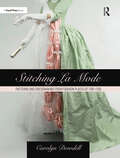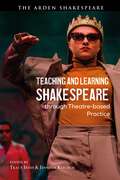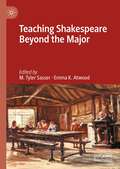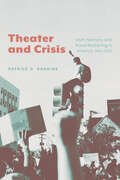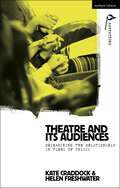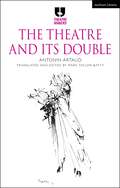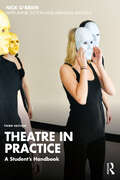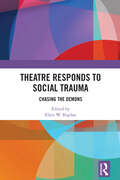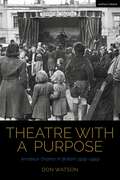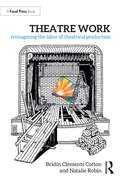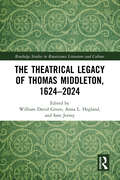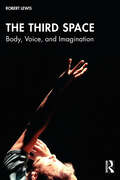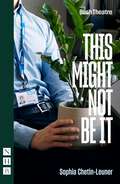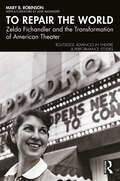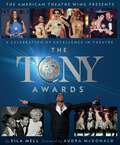- Table View
- List View
Stitching La Mode: Patterns and Dressmaking from Fashion Plates of 1785-1795
by Carolyn DowdellStitching La Mode: Patterns and Dressmaking from Fashion Plates of 1785-1795 brings to life women’s unique and extravagant fashions of 1785-1795 in a beautifully illustrated and accessible way. The book consists of scaled patterns directly based on original French, German and English fashion plates drafted according to period-accurate shapes. The patterns encompass the full look presented in each fashion plate from garments to accessories. These are accompanied by a color image of the corresponding fashion plate, straightforward, illustrated directions for recreating the outfits, information on the material used and modelled reproductions of each plate to demonstrate what they would look like in "real life". The book focuses on unique styles often seen in fashion plates but rarely – if ever – patterned before, making this a fresh and exciting yet historically accurate take on late eighteenth-century fashion. Stitching La Mode significantly expands the understanding of transitional fashions from the late eighteenth century with concrete, physical examples of styles, perfectly suited for costume technicians and makers, costume historians and hobby costumers and re-enactors.
Stitching La Mode: Patterns and Dressmaking from Fashion Plates of 1785-1795
by Carolyn DowdellStitching La Mode: Patterns and Dressmaking from Fashion Plates of 1785-1795 brings to life women’s unique and extravagant fashions of 1785-1795 in a beautifully illustrated and accessible way. The book consists of scaled patterns directly based on original French, German and English fashion plates drafted according to period-accurate shapes. The patterns encompass the full look presented in each fashion plate from garments to accessories. These are accompanied by a color image of the corresponding fashion plate, straightforward, illustrated directions for recreating the outfits, information on the material used and modelled reproductions of each plate to demonstrate what they would look like in "real life". The book focuses on unique styles often seen in fashion plates but rarely – if ever – patterned before, making this a fresh and exciting yet historically accurate take on late eighteenth-century fashion. Stitching La Mode significantly expands the understanding of transitional fashions from the late eighteenth century with concrete, physical examples of styles, perfectly suited for costume technicians and makers, costume historians and hobby costumers and re-enactors.
Teaching and Learning Shakespeare through Theatre-based Practice
by Tracy Irish and Jennifer KitchenHow can the study of Shakespeare contribute to equipping young people for the challenges of an uncertain future? This book argues for the necessity of a Shakespeare education that: finds meaning in the texts through inviting in the prior knowledge, experiences and ideas of students; combines intellectual, social and emotional learning; and develops a critical perspective on what a cultural inheritance is all about. It offers a comprehensive exploration of the educational principles underpinning theatre-based practice and explains how and why this practice can open up the possibilities of Shakespeare study in the classroom. It empowers Shakespeare educators working with young people aged 5-18 to interact critically, creatively and collaboratively with Shakespeare as a living artist.Drawing on the authors' research and experience with organizations including the Royal Shakespeare Company, Shakespeare's Globe, the Folger and Coram Shakespeare Schools Foundation, Part One consolidates recent developments in the field and engages in lively dialogue with core questions of Shakespeare's place in the classroom. Part Two curates a series of interviews with leaders and practitioners from the above and other Shakespeare institutions, exploring their core principles and practices. Part Three presents chapters from and about classroom teachers, who share their experiences of successfully embedding theatre-based approaches to Shakespeare in their own diverse contexts.
Teaching Shakespeare Beyond the Major
by M. Tyler Sasser Emma K. AtwoodThis edited collection considers the task of teaching Shakespeare in general education college courses, a task which is often considered obligatory, perfunctory, and ancillary to a professor’s primary goals of research and upper-level teaching. The contributors apply a variety of pedagogical strategies for teaching general education students who are often freshmen or sophomores, non-majors, and/or non-traditional students. Offering instructors practical classroom approaches to Shakespeare’s language, performance, and critical theory, the essays in this collection explicitly address the unique pedagogical situations of today’s general education college classroom.
Theater and Crisis: Myth, Memory, and Racial Reckoning in America, 1964-2020
by Patrice D. RankineRacial reckoning was a recurrent theme throughout the summer of 2020, a response to George Floyd’s murder and the unprecedented impact of COVID on marginalized groups. Theater and Crisis proposes a literary and theatrical study of how Floyd's killing could possibly happen in the aftermath of the Civil Rights era, and in the supposedly post-racial era following the election of Barack Obama. In the days and months following Floyd's death, there were nightly protests in streets across the United States and broader world. At the same time, theater performances were forced to shift online to video conferencing platforms and to find new ways to engage audiences. In each case, groups made shared meaning through storytelling and narrative, a liberatory process of myth-making and reverence that author Patrice D. Rankine calls “epiphanic encoding.” Rather than approaching the problem of racial reckoning through history, where periodization and progress are dominant narratives, Theater and Crisis argues that myth and memory allow for better theorization about recurring events from the past, their haunting, and what these apparent ghosts ask of us. Building on the study of myth as active, processual storytelling, Rankine acknowledges that it grounds and orients groups toward significant events. Theater and Crisis aligns narratives about Emmett Till, Trayvon Martin, and George Floyd, among others, with ancient, mythic figures such as Christ, Dionysus, Oedipus, and Moses. As living and verbal visitations, these stories performed on stage encode the past through their epiphanies in the present, urging audiences toward shared meaning. Rankine traces the cyclical hauntings of race through the refiguring of mythic stories across the past 75 years in the plays of James Baldwin, Ntozake Shange, Antoinette Nwandu, and many more, and in response to flashpoints in US racial history, such as the 1955 lynching of Emmett Till, the upheavals of the 1960s and 1970s, the wars on drugs and crime, and the continued violence against and disenfranchisement of Black people into the twenty-first century. Theater and Crisis explores the appearance of myth on the American stage and showcases the ongoing response by the theatrical establishment to transform the stage into a space for racial reckoning. This timely book is essential reading for scholars of theater studies, classics, and American studies.
Theater, Terror, Tod: Das Künstlerdrama von Christoph Schlingensief (Theater #166)
by Giovanna-Beatrice CarlessoChristoph Schlingensiefs autoreferenzielles Theater verhandelt Kunst- und Künstlerdiskurse im Kontext avantgardistischer Theorie und Praxis. In detaillierten Text- und Aufführungsanalysen nimmt Giovanna-Beatrice Carlesso zwei der komplexesten und anspielungsreichsten Inszenierungen des Autor-Regisseurs in den Blick, um ein dichtes Netz aus intermedialen Selbst- und Fremdzitaten im Nexus von Kunst, Terror und Tod zu entwirren. Dabei beleuchtet sie erstmals die longue durée des Künstlerdramas und erforscht dessen Weiterentwicklung durch Schlingensief in Zeiten der Postdramatik.
Theaterproben und Interaktion: Sprech- und theaterwissenschaftliche Perspektiven (Theater #159)
by Anna WesselWie werden künstlerische Ideen von Regie und Schauspieler*innen in Theaterproben interaktiv entwickelt, vermittelt und ausgehandelt? Anna Wessel betrachtet Probeninteraktionen aus sprechwissenschaftlicher Perspektive und kombiniert diese mit theaterwissenschaftlichen und linguistischen Aspekten. Dabei stellt sie die Besprechungsphasen von Theaterproben in den Fokus und zeigt auf, welche interaktiven Probenpraktiken zum Einsatz kommen, wie mit ihnen Instruktionen der Regie gestaltet werden und wie die Schauspieler*innen darauf sprachlich und spielend reagieren. Die Erkenntnisse liefern eine neue Perspektive auf interaktive Prozesse theatraler Probenarbeit - in Theorie und Praxis.
Theatre and Australia (Theatre And)
by Julian MeyrickHow has Australia developed, culturally? What is the relationship between European theatre and Aboriginal performance? How do the concepts of memory, space, and love intersect and inform all Australian drama?Theatre and Australia is a stark look at the signal contradictions that make up the nation's sense of self. Exploring how race, gender, and community have influenced Australia's cultural development, this book reveals the history of Australian theatre as a tussle with questions of identity that can neither be entirely repudiated nor fully resolved.This concise study traverses the narrative of Australian theatre since white settlement, examining some of the main plays and performances of the last 230 years, and illuminating the relationship between European, non-Indigenous, and First Nations drama.
Theatre and its Audiences: Reimagining the Relationship in Times of Crisis (Methuen Drama Agitations: Text, Politics and Performances)
by Kate Craddock Helen FreshwaterWritten in the aftermath of the Covid crisis, this book brings the past, present and future of theatre-going together as it explores the nature of the relationships between performance practitioners, arts organisations and their audiences. Proposing that the pandemic forced a re-evaluation of what it means to be an audience, and combining historical and current cultural sector perspectives, the book reflects on how historical conventions have conditioned present day expectations of theatre-going in the UK. Helen Freshwater examines the ways in which developments in technology, architecture and forms of communication have influenced what is expected by and of audiences, reflecting changes in theatre's cultural status and place in our lives. Drawing on the first-hand experiences of festival director and performance practitioner Kate Craddock, it also contends that practitioners now need to turn their attention to care, access and sustainability, arguing that the pandemic taught us, above all, that it is possible to do things differently. Part vision, part provocation, part critical interrogation, Theatre and its Audiences offers an insightful appraisal of past norms and assumptions to set out a bold argument about where we should go from here.
The Theatre and its Double (Theatre Makers)
by Antonin ArtaudIn The Theatre and Its Double, first published in 1938, Antonin Artaud puts forward his radical theories on drama and theatre, which he saw as being stifled by conservatism and a lack of experimentation.Containing the famous manifestos of the 'Theatre of Cruelty', this collection of essays analyses the underlying impulses of performance, provides suggestions on a physical-training method for actors, and features a long appreciation of the expressive values of Eastern dance drama.This new English translation of Artaud's canonical text by Mark Taylor-Batty retains the idiosyncratic nature of the author's writing, communicating its fervour and ambition, while achieving a much-needed clarity. Through doing so, it facilitates a fuller appreciation of Artaud's artistic objectives and the original context in which they grew, aided by a newly translated set of his notes and drafts, and a selection of letters to his publisher, friends and associates concerning the book's genesis and the evolution of the concept of a 'Theatre of Cruelty'. The commentary further contextualizes this material within Artaud's broader oeuvre, from his collaboration with the Surrealist group through to his plans to stage his own adaptation of Percy Shelley's Les Cenci in 1935.A welcome addition to any theatre-lover's or student's bookshelf, this translation of Artaud's classic text offers clear and faithful insights into Artaud's theatre.
Theatre in Practice: A Student's Handbook
by Nick O'BrienTheatre in Practice, third edition, is an accessible and wide-ranging exploration of the central practices and key practitioners covered on the various syllabi at A level, IB, and at undergraduate level.Exploring Stanislavski, Brecht, Artaud, Lecoq, Berkoff, Bogart, Mitchell and Craig, as well as work from innovative theatre companies such as Tamasha, Sh!T Theatre, Complicite, Gecko and The Paper Birds, it combines an informal, unpretentious tone with a wealth of practical exercises. Revised and updated to include some of the latest practices in theatre, this new edition offers a step-by-step approach to developing key skills such as devising, improvising, rehearsing mono/duologues and directing plays.New for this edition are chapters from Nick O'Brien and Mikhaela Mahony on key female and global majority practitioners; a chapter offering a unique insight into the acting practice of award-winning actress Indira Varma; and updated information throughout.Written by specialists with extensive experience at post-16 and undergraduate level, Theatre in Practice is a thorough and imaginative resource that speaks directly to students and teachers. This book offers students a range of exercises to experience and explore key practitioners enabling them to understand theatre how it should be understood: through practice.
Theatre in Practice: A Student's Handbook
by Nick O'BrienTheatre in Practice, third edition, is an accessible and wide-ranging exploration of the central practices and key practitioners covered on the various syllabi at A level, IB, and at undergraduate level.Exploring Stanislavski, Brecht, Artaud, Lecoq, Berkoff, Bogart, Mitchell and Craig, as well as work from innovative theatre companies such as Tamasha, Sh!T Theatre, Complicite, Gecko and The Paper Birds, it combines an informal, unpretentious tone with a wealth of practical exercises. Revised and updated to include some of the latest practices in theatre, this new edition offers a step-by-step approach to developing key skills such as devising, improvising, rehearsing mono/duologues and directing plays.New for this edition are chapters from Nick O'Brien and Mikhaela Mahony on key female and global majority practitioners; a chapter offering a unique insight into the acting practice of award-winning actress Indira Varma; and updated information throughout.Written by specialists with extensive experience at post-16 and undergraduate level, Theatre in Practice is a thorough and imaginative resource that speaks directly to students and teachers. This book offers students a range of exercises to experience and explore key practitioners enabling them to understand theatre how it should be understood: through practice.
Theatre Responds to Social Trauma: Chasing the Demons (Routledge Series in Equity, Diversity, and Inclusion in Theatre and Performance)
This book is a collection of chapters by playwrights, directors, devisers, scholars, and educators whose praxis involves representing, theorizing, and performing social trauma.Chapters explore how psychic catastrophes and ruptures are often embedded in social systems of oppression and forged in zones of conflict within and across national borders. Through multiple lenses and diverse approaches, the authors examine the connections between collective trauma, social identity, and personal struggle. We look at the generational transmission of trauma, socially induced pathologies, and societal re-inscriptions of trauma, from mass incarceration to war-induced psychoses, from gendered violence through racist practices. Collective trauma may shape, protect, and preserve group identity, promoting a sense of cohesion and meaning, even as it shakes individuals through pain. Engaging with communities under significant stress through artistic practice offers a path towards reconstructing the meaning(s) of social trauma, making sense of the past, understanding the present, and re-visioning the future.The chapters combine theoretical and practical work, exploring the conceptual foundations and the artists’ processes as they interrogate the intersections of personal grief and communal mourning, through drama, poetry, and embodied performance.
Theatre Responds to Social Trauma: Chasing the Demons (Routledge Series in Equity, Diversity, and Inclusion in Theatre and Performance)
by Ellen W. KaplanThis book is a collection of chapters by playwrights, directors, devisers, scholars, and educators whose praxis involves representing, theorizing, and performing social trauma.Chapters explore how psychic catastrophes and ruptures are often embedded in social systems of oppression and forged in zones of conflict within and across national borders. Through multiple lenses and diverse approaches, the authors examine the connections between collective trauma, social identity, and personal struggle. We look at the generational transmission of trauma, socially induced pathologies, and societal re-inscriptions of trauma, from mass incarceration to war-induced psychoses, from gendered violence through racist practices. Collective trauma may shape, protect, and preserve group identity, promoting a sense of cohesion and meaning, even as it shakes individuals through pain. Engaging with communities under significant stress through artistic practice offers a path towards reconstructing the meaning(s) of social trauma, making sense of the past, understanding the present, and re-visioning the future.The chapters combine theoretical and practical work, exploring the conceptual foundations and the artists’ processes as they interrogate the intersections of personal grief and communal mourning, through drama, poetry, and embodied performance.
Theatre with a Purpose: Amateur Drama in Britain 1919-1949 (Cultural Histories of Theatre and Performance)
by Don WatsonThis study of British amateur theatre in the inter-war period examines five different but interwoven examples of the belief, common in theatrical and educational circles at the time, that amateur drama had a purpose beyond recreation. Amateur theatre was at the height of its popularity as a cultural practice between the wars, so that by 1939 more British people had practical experience of putting on plays than at any time before or since.Providing an original account of the use of drama in adult education projects in deprived areas, and of amateur theatre in government-funded centres for the unemployed in the 1930s, it discusses repertoires, participation by working- class people and pioneering techniques of play-making. Amateur drama festivals and competitions were intended to raise standards and educate audiences. This book assesses their effect on play-making, and the use of innovative one-act plays to express contentious material, as well as looking at the Left Book Club Theatre Guild as an attempt to align the amateur theatre movement with anti-fascist and anti-war movements. A chapter on the Second World War rectifies the neglect of amateur theatre in war-time cultural studies, arguing that it was present and important in every aspect of war-time life.Don Watson builds on current scholarship and makes use of archival sources, local newspapers, unpublished scripts and the records of organizations not usually associated with the theatre. His work explores the range and diversity of amateur drama between the wars and the contributions it made to British theatre.
Theatre Work: Reimagining the Labor of Theatrical Production
by Brídín Clements Cotton Natalie RobinTheatre Work: Reimagining the Labor of Theatrical Production investigates both the history and current realities of life and work in professional theatrical production in the United States and explores labor practices that are equitable, accessible, and sustainable.In this book, Brídín Clements Cotton and Natalie Robin investigate the question of artmaking, specifically theatrical production, as work. When the art is the work, how do employers navigate the balance between creative freedom and these equitable, accessible, and sustainable personnel processes? Do theatrical production operations value the worker? Through data analyses, worker narratives, and analogues to the evolving gig economy, Theatre Work questions everything about theatrical production work – including our shared history, ways of operating, and assumptions about how theatre is made – and considers what might happen if the American Theatre was reborn in an entirely new form.Written for members of the theatrical production workplace, leaders of theatrical institutions and productions, labor organizers, and industry union leaders, Theatre Work: Reimagining the Labor of Theatrical Production speaks to the ways that employers and workers can reimagine how we work.
Theatre Work: Reimagining the Labor of Theatrical Production
by Brídín Clements Cotton Natalie RobinTheatre Work: Reimagining the Labor of Theatrical Production investigates both the history and current realities of life and work in professional theatrical production in the United States and explores labor practices that are equitable, accessible, and sustainable.In this book, Brídín Clements Cotton and Natalie Robin investigate the question of artmaking, specifically theatrical production, as work. When the art is the work, how do employers navigate the balance between creative freedom and these equitable, accessible, and sustainable personnel processes? Do theatrical production operations value the worker? Through data analyses, worker narratives, and analogues to the evolving gig economy, Theatre Work questions everything about theatrical production work – including our shared history, ways of operating, and assumptions about how theatre is made – and considers what might happen if the American Theatre was reborn in an entirely new form.Written for members of the theatrical production workplace, leaders of theatrical institutions and productions, labor organizers, and industry union leaders, Theatre Work: Reimagining the Labor of Theatrical Production speaks to the ways that employers and workers can reimagine how we work.
The Theatrical Legacy of Thomas Middleton, 1624–2024 (Routledge Studies in Renaissance Literature and Culture)
This volume celebrates Thomas Middleton’s legacy as a dramatist, marking the 400th anniversary of Middleton’s final and most contentious work for the public theatres, A Game at Chess (1624).The collection is divided into three sections: ‘Critical and Textual Reception’, ‘Afterlives and Legacies’, and ‘Practice and Performance’. This division reflects the book’s holistic approach to Middleton’s canon, and its emphasis on the continuing significance of Middleton’s writing to the study of early modern English drama. Each section offers an assessment of the place of Middleton’s drama in culture, criticism, and education today through a range of critical approaches.Featuring work from a range of voices (from early career, independent, and seasoned academics and practitioners), the collection will be appropriate for both specialists in early modern literature and drama who are interested in both theory and practice, and students or scholars researching Middleton’s historical significance to the study of early theatre.
The Theatrical Legacy of Thomas Middleton, 1624–2024 (Routledge Studies in Renaissance Literature and Culture)
by William David Green Anna L. Hegland Sam JermyThis volume celebrates Thomas Middleton’s legacy as a dramatist, marking the 400th anniversary of Middleton’s final and most contentious work for the public theatres, A Game at Chess (1624).The collection is divided into three sections: ‘Critical and Textual Reception’, ‘Afterlives and Legacies’, and ‘Practice and Performance’. This division reflects the book’s holistic approach to Middleton’s canon, and its emphasis on the continuing significance of Middleton’s writing to the study of early modern English drama. Each section offers an assessment of the place of Middleton’s drama in culture, criticism, and education today through a range of critical approaches.Featuring work from a range of voices (from early career, independent, and seasoned academics and practitioners), the collection will be appropriate for both specialists in early modern literature and drama who are interested in both theory and practice, and students or scholars researching Middleton’s historical significance to the study of early theatre.
The Third Space: Body, Voice, and Imagination
by Robert LewisThe Third Space serves a crucial need for contemporary performers by providing an interdisciplinary and physiovocal approach to training. It is a new take on body and voice integration designed to develop the holistic performer. It takes performers through a series of step-by-step practical physiovocal exercises that connects the actor’s centre to the outside world, which increases awareness of self and space. It also develops a deeper connection between spaces within the body and the environment by connecting sound, imagination, and movement.Robert Lewis’s approach is a way of working that unlocks the imagination as well as connecting performers to self, space, and imagination, through voice and body. It conditions, controls, and engages performers by integrating various voice and movement practices.The theories and practice are balanced throughout by: introducing the practical works theoretical underpinnings through research, related work, and case studies of performances; demonstrating a full program of exercises that helps performers get in touch with their centre, their space, and shape both within and outside the body; and exploring the performers physiovocal instrument and its connection with imagination, energies, and dynamics. This book is the result of nearly 20 years of research and practice working with voice and movement practitioners across the globe to develop training that produces performers that are physiovocally ready to work in theatre, screen, and emergent technologies.
The Third Space: Body, Voice, and Imagination
by Robert LewisThe Third Space serves a crucial need for contemporary performers by providing an interdisciplinary and physiovocal approach to training. It is a new take on body and voice integration designed to develop the holistic performer. It takes performers through a series of step-by-step practical physiovocal exercises that connects the actor’s centre to the outside world, which increases awareness of self and space. It also develops a deeper connection between spaces within the body and the environment by connecting sound, imagination, and movement.Robert Lewis’s approach is a way of working that unlocks the imagination as well as connecting performers to self, space, and imagination, through voice and body. It conditions, controls, and engages performers by integrating various voice and movement practices.The theories and practice are balanced throughout by: introducing the practical works theoretical underpinnings through research, related work, and case studies of performances; demonstrating a full program of exercises that helps performers get in touch with their centre, their space, and shape both within and outside the body; and exploring the performers physiovocal instrument and its connection with imagination, energies, and dynamics. This book is the result of nearly 20 years of research and practice working with voice and movement practitioners across the globe to develop training that produces performers that are physiovocally ready to work in theatre, screen, and emergent technologies.
This Might Not Be It (Nhb Modern Plays Ser.)
by Sophia Chetin-LeunerJay's new. He's just started as a temp in NHS Child and Adolescent Mental Health Services. He arrives with little more than a fledgling desk plant and well-meaning plans to change the broken system. Angela's been working here for over thirty years and nothing seems to faze her – except Jay. Exhausted and worn down by archaic protocol, Jay starts bending the rules in a desperate attempt to help their patients. But when professional boundaries are crossed and trust is shattered, he discovers the harsh reality of what's truly at stake. Sophia Chetin-Leuner's play This Might Not Be It is a candid portrayal of human lives at the mercy of our crumbling NHS. The play was longlisted for the Verity Bargate Award and shortlisted for the Women's Prize for Playwriting. It was premiered at the Bush Theatre, London, in 2023, directed by Ed Madden and produced by Broccoli Arts and Jessie Anand Productions. 'The beauty of this piece is that it speaks in a universal language about the way people find ways of co-existing in an office where space is tight and time is short' - The Times 'Intriguing and immensely engaging' - Guardian 'Timely and compelling& the characters are startlingly vivid, filled with hopes, flaws and intriguing contradictions' - The Stage 'Affecting, with much to admire' - Telegraph
To Repair the World: Zelda Fichandler and the Transformation of American Theater (ISSN)
by Mary B. RobinsonThis book is a biography in the form of an oral history about a woman whose founding of Arena Stage in Washington, DC in 1950 shifted live professional theater away from Broadway and inspired the creation of non-profit theaters around the country. Dianne Wiest, James Earl Jones, Stacy Keach, and Jane Alexander, among many others, share their memories of this intrepid pioneering woman during Arena Stage’s early years.As Head of New York University’s Graduate Acting Program for 25 years, Zelda Fichandler also trained a younger generation of gifted actors. Marcia Gay Harden, Rainn Wilson, Mahershala Ali, and other developing actors who became “artist-citizens” under her guidance, talk about the ways in which she transformed their lives.Theater practitioners who have lived during Zelda Fichandler’s time will find this book a fascinating and entertaining read––as will all theater lovers, especially those in Washington, DC. And through this vivid and compelling oral history, students and aspiring artists will come to grasp how the theatrical past can shed essential light on the theater of today and tomorrow.
To Repair the World: Zelda Fichandler and the Transformation of American Theater (ISSN)
by Mary B. RobinsonThis book is a biography in the form of an oral history about a woman whose founding of Arena Stage in Washington, DC in 1950 shifted live professional theater away from Broadway and inspired the creation of non-profit theaters around the country. Dianne Wiest, James Earl Jones, Stacy Keach, and Jane Alexander, among many others, share their memories of this intrepid pioneering woman during Arena Stage’s early years.As Head of New York University’s Graduate Acting Program for 25 years, Zelda Fichandler also trained a younger generation of gifted actors. Marcia Gay Harden, Rainn Wilson, Mahershala Ali, and other developing actors who became “artist-citizens” under her guidance, talk about the ways in which she transformed their lives.Theater practitioners who have lived during Zelda Fichandler’s time will find this book a fascinating and entertaining read––as will all theater lovers, especially those in Washington, DC. And through this vivid and compelling oral history, students and aspiring artists will come to grasp how the theatrical past can shed essential light on the theater of today and tomorrow.
The Tony Awards: A Celebration of Excellence in Theatre
by Eila Mell The American Theatre WingCommemorating over 75 years of Broadway greatness with never-before told stories, rare photos from the American Theatre Wings' archives, and interviews with major honorees like Lin-Manuel Miranda, Patti LuPone, and Hugh Jackman, The Tony Awards is the official, authorized guide to Broadway's biggest night.The Tony Awards: A Celebration of Excellence in Theatre pays tribute to the magic that happens when the curtain goes up and Broadway's best and brightest step onto center stage. Supported by the American Theatre Wing, the arts organization that founded the Tony Awards in 1947 and continues to produce the Tony Awards live telecast each year, author Eila Mell has interviewed a cavalcade of past and present Tony winners, including actors, producers, writers, costume designers, and many many others. Their voices fill the pages of this book with fascinating, behind-the-scenes stories about what it's like to win the theatre world's highest honor. Featuring a foreword by Audra McDonald and over 400 color and black-and-white photographs, The Tony Awards also spotlights more than 130 captivating interviews with a parade of industry insiders, including: Mel Brooks, Matthew Broderick, Carol Burnett, Kristin Chenoweth, Glenn Close, James Corden, Bryan Cranston, Neil Patrick Harris, Jennifer Holliday, Hugh Jackman, John Kander, Angela Lansbury, Judith Light, Hal Linden, Kenny Leon, Patti LuPone, Lin-Manuel Miranda, Brian Stokes Mitchell, Rita Moreno, Bernadette Peters, Chita Rivera, Martin Short, Tom Stoppard, Julie Taymor, Leslie Uggams, and Sir Andrew Lloyd Webber.
